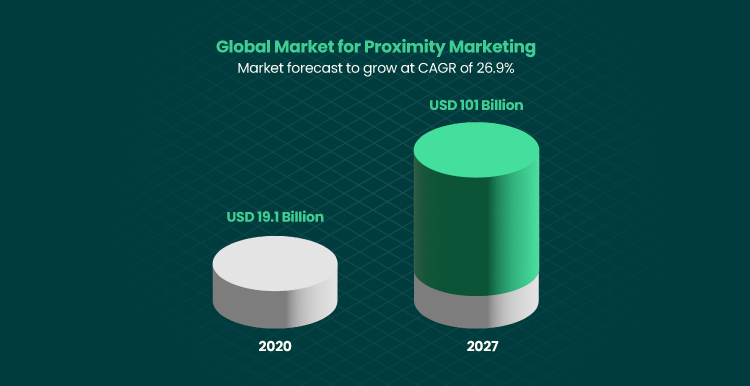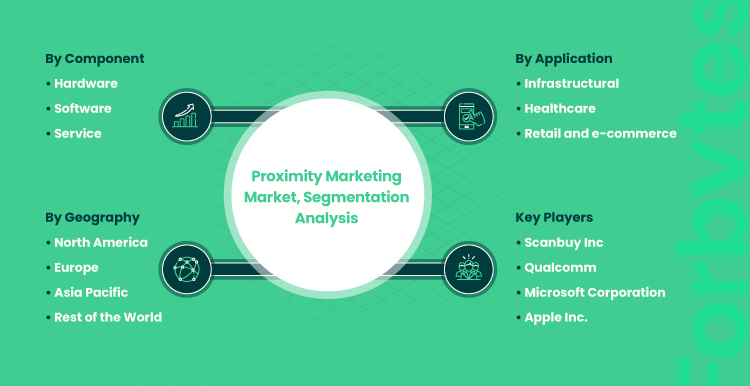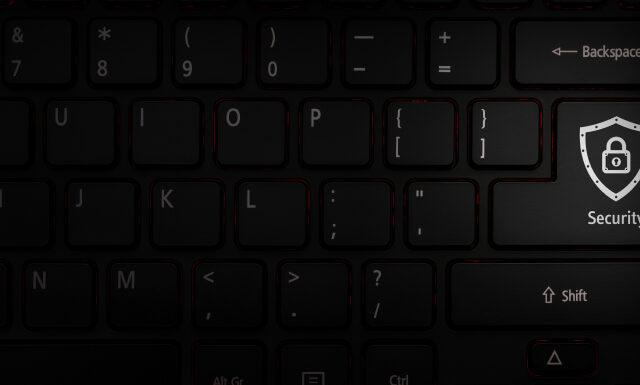The development of technology provides new opportunities for businesses to grow. This concerns proximity marketing. When businesses implement proximity marketing, the ad campaigns reach a more personal level with their audience, adding a more engaging and personalized touch.
In this article, we’ll cover what proximity marketing is and what benefits it brings to businesses.
The Concept of Proximity Marketing
A method of location-based marketing via a company’s use of their customers’ location is a foundation for a Bluetooth proximity marketing strategy. Businesses of all sizes use proximity marketing to engage with potential customers, as long as they’re physically close to the business. It makes ads more practical and effective, as well as more personal.
The aim of proximity-based marketing is to deliver marketing campaigns to consumers in close proximity to retailers, restaurants, or other locations of interest to the target audience. This proximity marketing system is designed to identify the customer profile and send the message directly to the person. People can receive marketing messages in the form of coupons or discount cards, advertisement banners in the store, or a personalized advertisement on a store companion website. For instance, advertising a café located near a certain event center will encourage visitors to events held in that center (concerts, shows, booths, etc.) to visit the café to order coffee.
The idea of the proximity marketing technique is that a specific message can only be communicated to the right person by its proximity. As a rule, this is done by utilizing mobile location tech technologies, such as GPS. But proximity technologies such as Bluetooth technology and WiFi also serve this type of marketing. Bluetooth-enabled mobile devices are frequently used to engage the audience.
Proximity marketing has been used in the retail and tourism industries to connect visitors with nearby locations that might not be able to draw them in otherwise. In recent years, there has been an increase in the use of proximity marketing to create highly targeted, hyper-local sales campaigns. A hyper-local sales campaign is one in which a local retailer maximizes their geographic location to house a specific sales event and makes use of the surrounding local culture to generate interest.
Types of Proximity Marketing Solutions
The world’s proximity marketing share is segmented based on technology, location, component, application, and geography.
Source: Verified Market Research
Here are several types of proximity marketing technology solutions you should consider before building your marketing strategy.
WiFi Proximity Marketing
Providing access to high-speed, reliable WiFi is now a must for retailers, as more and more customers are seeking convenience-driven in-store experiences.
WiFi proximity marketing is integrated with in-store marketing to provide guests with personalized, customer-activated content based on their proximity. See, allowing a free WiFi connection for the visitors of your store is actually granting you a valuable asset: consumer data. When a customer wants to log in to your WiFi network, ask them to provide their email first so you can reach out to them later and send personalized marketing messages.
Thus, in-store WiFi proximity marketing lets you tap into data seamlessly, across your business to establish a well-targeted marketing audience. Afterward, you can create in-store specific campaigns by leveraging the user-provided data.
RFID/NFC Proximity Marketing
More and more companies are looking for new ways to boost their online visibility with convenience, personalization, and interaction. One such method is a radio-frequency identification (RFID) proximity marketing. It allows companies to embed a unique identifier on their product, insert it into the RFID proximity marketing imaging system, and then automatically customize their targeting. Similar to geofencing, RFID proximity marketing happens when specific content or promotions are pushed to mobile devices in a limited area.
Near field communication (NFC) proximity marketing is a marketing tactic in which retailers put a chip on the product that works as a transmitter and connects to in-store visitors’ mobiles to send them various info about certain products.
This technology enables marketers to establish a real-time connection with their customers, receiving vital info about customer behavior in the store.
GPS-Based Proximity Marketing
With astonishing accuracy and high efficiency, proximity marketing allows brands to base ad targeting on meaningful data points like demographic, location/geography, platform, and time. This relates to GPS-based proximity marketing. Also called geo-targeting and geo-marketing, this tactic lets companies identify and engage customers based on their location. It is mainly used in retail, services, and real estate.
For instance, if you live or work near a particular physical location or an organization/business, you might be willing to make a purchase or other preference-based commitment to that entity. Those locations – your local grocery store, fitness club, a particular bar- can leverage that information to send you exclusive offers and promotions.
Beacons-Based Proximity Marketing
If the next-century retail experience takes shape around the idea of location-based advertising, then beacons will be the way to go with it. Beacons, easily installed in every store and retail space, use an electrical signal to identify customer location and transmit data to them through a Bluetooth-enabled mobile device. Retailers calculate daily traffic patterns and broadcast promotional messages to individuals nearby, making product recommendations or simply notifying them of discounts and beneficial deals.
Modern business owners rely on digital marketing channels for both growth and retention. Let’s say you want to promote a new product around your neighborhood, but you’d rather not disturb your neighbors. Well, now there’s an easier way. Beacons use high-tech radio signals to provide specific content and marketing messages based on location. They are easily installed in venues to transmit personalized, contextual information to smartphone users. Beacons can create interactive experiences and offer valuable information (such as displaying discounts) to smartphone users as they walk near to encourage them to stay or shop longer or make a purchase.
Alternative Proximity Marketing Solutions
Beacons are seen as the next step in the evolution of somewhat antiquated “point-of-sale” marketing. Smartphone-equipped shoppers with a beacon-enabled shopping app can see special deals as they walk or drive by specific locations. However, this technology is still considered to be one of the most expensive ones for marketing purposes.
There are less expensive proximity marketing solutions for budget ad campaigns. For instance, QR codes or (Quick Response) codes are a powerful tool that allows companies to create digital proximity marketing opportunities by simply creating one and hanging it on the wall in the store.
Another way is mobile browser detection. When visitors arrive at your website, many factors are taken into account, including their IP address, browser, and device. Every time a visitor to your website activates their mobile phone or pulls up your page on their laptop browser, you have a chance to reach out and, potentially, monetize them. On the other hand, visitors that don’t activate their mobile phones are harder to engage with outreach.
Proximity Marketing Benefits
Location-based advertising is changing the way brands engage with consumers. We live in an increasingly digital world. As technology speeds up and customer demands become increasingly complex, it is easier and faster for them to find like-minded brands in their proximity. With more connection and free access to a wide range of ideas and opinions, this has become an integral part of how the world functions.
In addition, the growing use and usefulness of data mean marketers can better understand their target audience. That analysis can lead to better product design, more effective advertising, and better ways to target customers.
- Enhanced customer experience: The use of a proximity marketing strategy enables your company to personalize the customer experience in a way that varies your offerings based on the targeted customer’s past, present, or future location and behavior.
- App utilization: The use of proximity ads to provide valuable info and offers can improve user interaction with a proximity-aware mobile app, which can be a place for users to read regular updates, withdraw discounts, etc.
- Cost-effectiveness: Mobile proximity marketing is a cost-efficient way to target ads to the desired audience.
- Customer relationship boost: Proximity ads help businesses better understand the needs of their customers. This allows them to meet these needs to enhance relationships and interactions.
Proximity marketing is about making a connection with customers that is more meaningful and inherently humanizes the relationship.
Industries Where Beacons Are Used
The use of new technologies in retail can increase consumer engagement, brand awareness, conversion, and overall sales and retention. Beacons can transform physical spaces into digital ones, delivering a personalized experience for their users and by extension, increasing the value of their brand. They can track consumers in physical locations to learn about their habits and preferences.
However, retail is not the only industry that uses this tiny fancy technology.
Beacons for the Airline Industry
Travelers are going digital to find the best deals and destinations in the airline industry. And since airports can be a bit confusing to navigate through, beacons can help make the experience less stressful and more convenient.
In the airline industry, proximity marketing beacons are placed in various parts of the airport, including airport ticket counters, gates, and baggage claim areas. Along with the beacons, airports deploy GPS tracking to allow the origin and destination of passengers to be tracked to see if it would be beneficial to offer extra incentives or promotions based on their route.
Airport-located companies are also expanding their use of beacons in airports to reach potential customers and increase profits. That’s because a random airport is usually staffed with various stores, and beacons help them track and reach passengers to attract them to the stores.
Beacons for Hospitality
The tourist industry has always been particularly profitable, and it still is. Also, it always strives for improvement and utilization of the latest technologies to make visits as convenient as possible. Hotels are always trying to offer tailored and location-specific experiences to their guests. Beacons could offer hospitality marketers and property managers unique insights into the customer’s personal data and preferences.
For instance, hotel visitors can receive information about the hotel and the various offers it has. Also, as guests are looking for the best cafes or restaurants for a good price, hotels can partner with local bars and restaurants and inform the guests of the deals they could get.
Beacons for Sports Industry
Beacons also offer opportunities for marketers to bring enhanced experiences to sports fans in a confined area or event. The Catalonian Camp Nou, Barcelona’s football team stadium, is a perfect illustration of the beacon’s utilization. When sports fans arrive, they receive notifications about FC Barcelona, the latest updates and news related to the club, ticket availability, and existing offers in the official stores of the football team.
How Effective Is Proximity Marketing?
Let’s take a look at some use cases of proximity marketing strategies. Below, we described popular brands that use this type of advertising, each set to reach specific goals. Let’s see what they’ve managed to accomplish.
Ulta Beauty is a beauty brand that decided to leverage proximity advertising to promote its new business asset location opening. So, the brand decided to target ads at people located within the area of its new store.
As a result, their new store gained much recognition and actually turned out to be much more successful than the already existing locations. Beacons helped them to achieve their average weekly objectives around 45% quicker and 26 days earlier than the stores they didn’t place beacons in.
OneSight utilized beacons to reach users that wear glasses and are actively using a mobile device. They targeted specifically the eyewear store visitors who were interested in specific kinds of glasses – sight protection ones. As a result, this marketing strategy delivered excellent results: the ad campaign delivered a sounder clickthrough rate than predicted and conveyed the company’s statement directly to potential consumers. The end result exceeded expectations by 20%.
Toyota also resorted to proximity targeting in order to reach potential buyers of their new model. The goal was to stimulate them to visit local Toyota stores. As a result, 1,200 potential buyers reached with the help of their beacon-based targeting actually visited the store.
Final Word
Our smartphones have changed how we shop, work, socialize, and live. It’s no wonder that so many businesses are taking on the challenge of mobile proximity marketing.
In fact, proximity marketing gains momentum and becomes a promising industry segment. Businesses are uncovering the benefits of marketing to clients in their proximity. Localization is already happening as more and more companies start to operate on a global scale. This ecommerce trend is poised for solid growth as it creates new opportunities for brands to grow their customer base and earnings. Proximity marketing campaigns showcase tells us a number of inspiring stories on how to get closer to those who are already close to you.
Wonder how to use proximity marketing for your business goals? Contact us and we’ll gladly help you!

Our Engineers
Can Help
Are you ready to discover all benefits of running a business in the digital era?

Our Engineers
Can Help
Are you ready to discover all benefits of running a business in the digital era?










